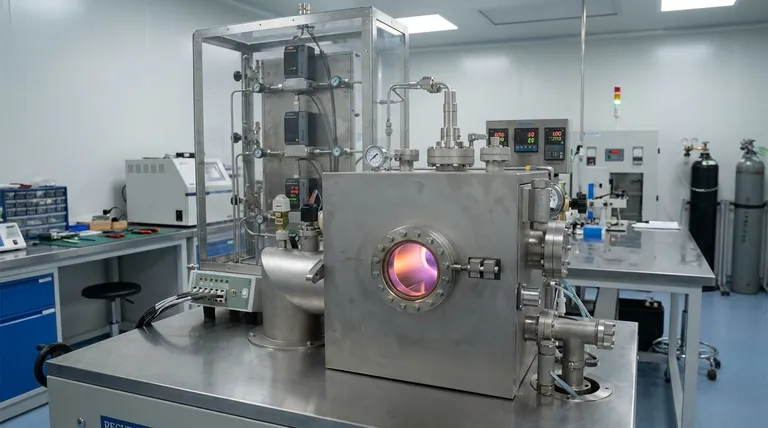At its core, deposition technology is good because it allows us to build functional materials and thin films from the ground up, one layer of atoms or molecules at a time. For example, a technique like Hot-Filament Chemical Vapor Deposition (HFCVD) is used to create industrial diamond films because it combines low cost and simple equipment with the ability to coat large areas, making advanced materials practical for real-world applications.
The true value of deposition is not merely in applying a coating. It is the power to precisely engineer a material's properties—such as hardness, conductivity, or optical behavior—by controlling its structure at a near-atomic level.

What Exactly Is Deposition Technology?
Deposition refers to a family of processes where a material in a vapor state is condensed to grow a solid film onto a surface, known as a substrate. Think of it as a form of highly controlled, atomic-level spray painting.
The Fundamental Principle: Additive Construction
Unlike subtractive manufacturing, where you cut material away from a larger block, deposition is fundamentally an additive process.
This bottom-up approach is what enables the creation of structures and materials with properties that are impossible to achieve through traditional melting or machining.
Two Major Families: PVD and CVD
While there are many specific techniques, they generally fall into two categories.
Physical Vapor Deposition (PVD) involves physically moving a material from a source to the substrate. This can be done by vaporizing it with heat (evaporation) or by bombarding it with ions to knock atoms loose (sputtering).
Chemical Vapor Deposition (CVD), which includes the HFCVD example, uses precursor gases that react or decompose on the substrate's surface to form the desired material. The chemistry of the process defines the final film.
The Key Industrial Advantages
The decision to use deposition technology is driven by several powerful benefits that are difficult or impossible to replicate with other manufacturing methods.
Unprecedented Control Over Material Properties
By precisely managing process parameters like temperature, pressure, and gas composition, you can dictate the film's thickness, density, crystal structure, and purity.
This control allows for the creation of coatings that are harder than steel, more conductive than copper, or that reflect specific wavelengths of light.
Versatility Across Materials and Substrates
Deposition is incredibly versatile. It can be used to deposit metals, ceramics, polymers, and composite materials onto a wide range of substrates, including silicon wafers, glass, metal tools, and flexible plastics.
This makes it a cornerstone technology for industries ranging from semiconductors and aerospace to medical devices and optics.
Scalability and Economic Efficiency
Many deposition techniques, like the HFCVD process for diamond films, are valuable because they are scalable for mass production.
The ability to coat large areas uniformly or process many parts in a single batch makes the technology cost-effective for industrial applications, moving advanced materials from the lab to the marketplace.
Understanding the Trade-offs
While powerful, deposition is not a universal solution. A clear understanding of its limitations is critical for successful implementation.
Process Complexity
Deposition systems are not simple machines. They often require high vacuum, precise temperature control, and complex gas handling systems.
Achieving a repeatable, high-quality result demands significant process expertise and careful calibration.
Balancing Deposition Rate and Quality
There is often a direct trade-off between the speed of deposition and the quality of the resulting film.
Depositing material too quickly can introduce defects, stress, and poor structure, compromising the film's performance. The highest-quality films often require slow, carefully controlled growth.
Adhesion and Compatibility
A deposited film is only as good as its bond to the substrate. Poor adhesion is a common failure mode.
Ensuring strong adhesion requires careful substrate cleaning, surface preparation, and sometimes the use of intermediate bonding layers, adding steps and complexity to the process.
Making the Right Choice for Your Goal
Selecting the correct deposition method depends entirely on your specific technical and business objectives.
- If your primary focus is creating ultra-pure, dense films with exceptional mechanical properties: PVD techniques like sputtering are often the superior choice.
- If your primary focus is coating complex 3D shapes uniformly or requires a specific chemical reaction: CVD methods provide better "throwing power" to cover all surfaces evenly.
- If your primary focus is cost-effective industrial scaling: You must evaluate specific techniques like HFCVD or plasma-enhanced CVD (PECVD) that are optimized for high throughput and large-area coverage.
Ultimately, deposition technology empowers you to move beyond simply using materials to designing them with intent.
Summary Table:
| Aspect | Key Advantage |
|---|---|
| Material Control | Precise engineering of properties (hardness, conductivity) at near-atomic level |
| Versatility | Deposits metals, ceramics, polymers on various substrates (silicon, glass, plastics) |
| Scalability | Cost-effective for mass production and large-area coatings (e.g., HFCVD for diamond films) |
| Process Type | Additive manufacturing method (PVD and CVD techniques) |
Ready to engineer superior materials with precision?
KINTEK specializes in advanced deposition equipment and consumables for laboratories. Whether you need to develop hard coatings, conductive films, or optical layers, our solutions provide the control and scalability your research demands.
Contact our experts today to discuss how our deposition technology can accelerate your materials development and bring your innovative applications to life.
Visual Guide

Related Products
- Inclined Rotary Plasma Enhanced Chemical Vapor Deposition PECVD Equipment Tube Furnace Machine
- HFCVD Machine System Equipment for Drawing Die Nano-Diamond Coating
- 915MHz MPCVD Diamond Machine Microwave Plasma Chemical Vapor Deposition System Reactor
- Vacuum Hot Press Furnace Machine for Lamination and Heating
- CVD Diamond Cutting Tool Blanks for Precision Machining
People Also Ask
- What is plasma enhanced chemical vapour deposition process? Unlock Low-Temperature, High-Quality Thin Films
- What is the difference between CVD and PECVD? Choose the Right Thin-Film Deposition Method
- What is PECVD silicon deposition? Achieve Low-Temperature, High-Quality Thin Films
- What is PECVD used for? Achieve Low-Temperature, High-Performance Thin Films
- What is plasma in CVD process? Lowering Deposition Temperatures for Heat-Sensitive Materials



















